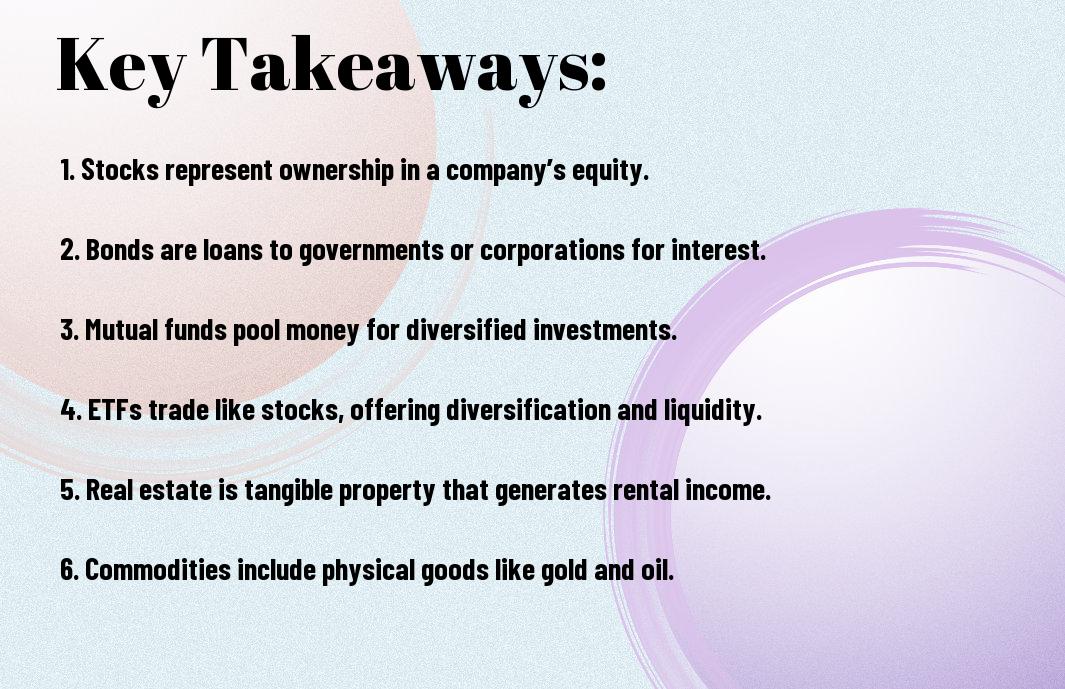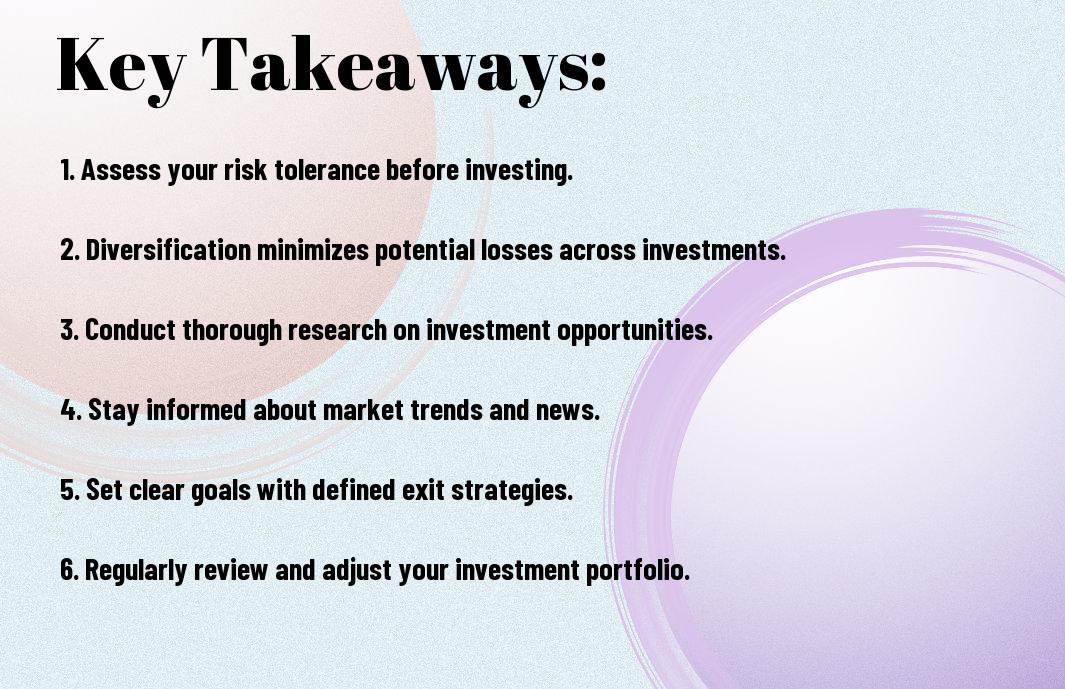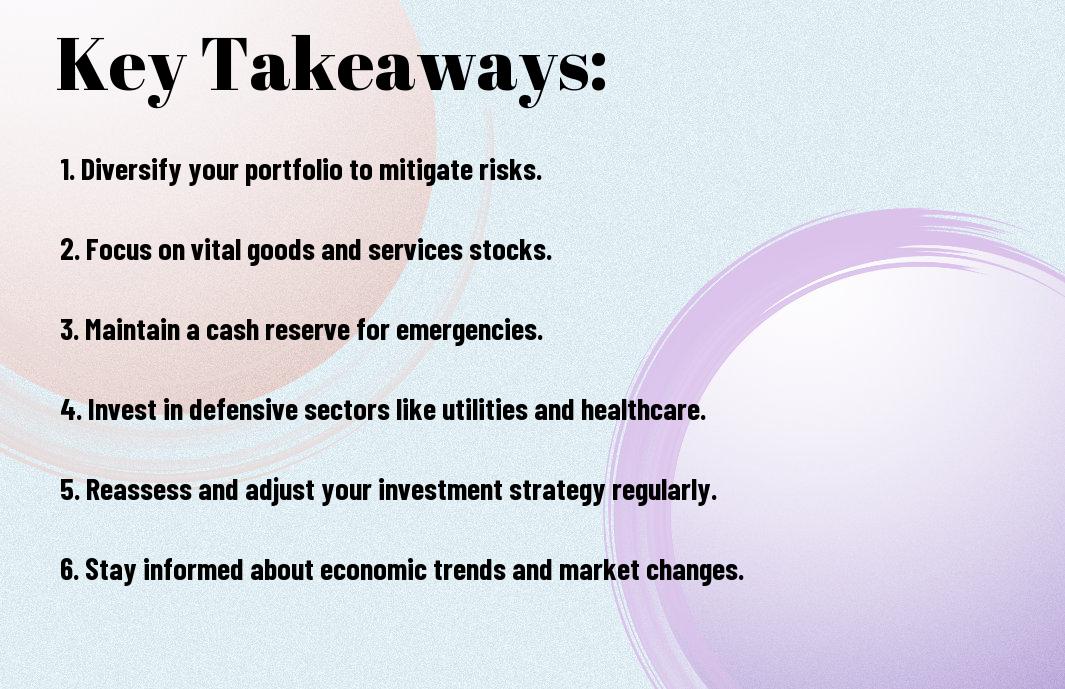Just exploring investment options can feel overwhelming with the sheer variety available. Understanding the different types of investments is crucial for you to make informed decisions that align with your financial goals. This guide will break down each option, from stocks and bonds to real estate and mutual funds, helping you navigate the investment landscape effectively. By gaining clarity on these categories, you can build a diverse portfolio that suits your risk tolerance and investment timeline.
Key Takeaways:
- Asset Classes: Investments can be categorized into several asset classes such as stocks, bonds, real estate, and commodities, each with unique characteristics and risk levels.
- Risk and Return: Generally, higher potential returns come with higher risks; understanding this trade-off is vital when choosing investments.
- Diversification: Spreading investments across various asset classes can help reduce risk and improve potential returns by offsetting losses in one area with gains in another.
- Investment Horizon: The time frame for holding an investment can influence the type of investment chosen, as short-term and long-term goals may require different strategies.
- Market Conditions: Economic factors and market conditions can significantly impact investment performance, making it important to stay informed and adjust portfolios accordingly.


Understanding Investment Basics
For anyone looking to grow their wealth, understanding the basics of investing is crucial. Investments are not just about putting your money in stocks or bonds; they encompass a wide range of asset classes and strategies. By grasping fundamental concepts, you can make informed decisions that align with your financial goals and risk tolerance.
Definition of Investments
Along your investment journey, it is important to recognize that investments are assets purchased with the expectation of generating a return over time. These assets can include stocks, bonds, real estate, or even alternative investments, each serving distinct purposes in building your financial future.
Importance of Diversification
Around the world of investing, diversification is a key strategy that helps you manage risk. By spreading your investments across various asset classes and sectors, you can reduce the impact of any single investment’s poor performance on your overall portfolio. This approach allows you to capitalize on different growth opportunities while mitigating the potential downsides.
This strategy is particularly beneficial in volatile markets. When one sector faces challenges, others may thrive, providing a buffer for your overall returns. By maintaining a diversified portfolio, you enhance your chances of achieving steady growth while safeguarding your investments against unpredictable shifts in the market. Whether you are a novice or experienced investor, embracing diversification can lead to more stable and sustainable financial success over time.
Traditional Investment Types
It is crucial to understand the various traditional investment types that can form the cornerstone of your portfolio. These investments typically provide more stability and lower risk compared to alternative ventures. Some notable types include:
- Stocks
- Bonds
- Mutual Funds
- Real Estate
- Certificates of Deposit (CDs)
After exploring these options, you can make informed decisions about which investments align with your financial goals and risk tolerance.
| Type | Description |
|---|---|
| Stocks | Ownership shares in a company that can appreciate in value. |
| Bonds | Loans to corporations or governments that pay interest. |
| Mutual Funds | Pools of funds collected from many investors to invest in diversified assets. |
| Real Estate | Physical property investments that can provide rental income. |
| CDs | Time deposits offered by banks with fixed interest rates. |
Stocks
By investing in stocks, you acquire a share of ownership in a company, which means you’re entitled to a portion of its profits. Stocks can appreciate over time, potentially leading to significant capital gains, making them an attractive option for growth-oriented investors. However, they also come with higher volatility and risk, necessitating careful research and consideration.
Bonds
Types of bonds are fixed-income instruments issued by corporations or governments to raise capital. When you buy a bond, you crucially lend money to the issuer in exchange for periodic interest payments and the return of the principal upon maturity. Bonds are often viewed as a safer investment compared to stocks, providing a steady income stream for investors.
For instance, government bonds, such as U.S. Treasuries, are considered low-risk investments due to their backing by the government. Corporate bonds may offer higher yields but carry more risk based on the issuing company’s creditworthiness. This diversity within bonds allows you to select options aligning with your financial strategies and risk appetite.
Real Estate Investments
Once again, real estate investments represent a tangible asset class that can provide both income and capital appreciation. This sector includes various property types, from residential and commercial buildings to raw land. Investing in real estate allows you to diversify your portfolio and potentially hedge against inflation, as property values typically rise over time. Whether you are a seasoned investor or just starting, understanding how real estate functions is vital for leveraging its benefits.
Residential Properties
By investing in residential properties, you engage in the buying, renting, or selling of homes and apartments. This sector often provides a steady rental income and can appreciate over time, balancing the risks inherent in real estate. As a residential property owner, you have the opportunity to create a passive income stream while also benefiting from tax deductions related to mortgage interest and maintenance costs.
Commercial Real Estate
Around the world, commercial real estate includes properties that are primarily used for business purposes, such as office buildings, retail spaces, and industrial properties. This form of investment typically offers higher yield potential compared to residential properties. Often leases are more extended, providing you with a more stable income source. However, commercial real estate requires a deeper understanding of market dynamics, tenant negotiation, and property management.
Real commercial real estate investments can be lucrative, but they come with unique challenges. You need to consider property location, market trends, and the economic health of tenants. Additionally, the upfront capital requirements can be higher, and property management can be more complex. However, successful investments in this realm may yield substantial returns, making it an attractive option for investors seeking higher cash flow and long-term growth potential.
Alternative Investments
Many investors seek diversification beyond traditional stocks and bonds by exploring alternative investments. These options can include assets like real estate, hedge funds, and private equity. If you want to learn more, check out 11 Common Types of Investments and How They Work. These investments can offer unique advantages, such as protection against market volatility and access to higher potential returns.
Commodities
After analyzing your investment strategy, you may want to consider commodities, which include physical goods like gold, silver, oil, and agricultural products. Commodities can serve as a hedge against inflation and offer portfolio diversification due to their low correlation with traditional assets.
Cryptocurrencies
Behind the buzz of the financial world are cryptocurrencies, a digital form of currency that uses blockchain technology. As you evaluate your investment options, consider that cryptocurrencies like Bitcoin and Ethereum have emerged as alternative assets with significant price volatility, drawing the interest of many investors.
Hence, understanding cryptocurrencies involves recognizing both their potential and risks. With their decentralized nature and ability to offer high returns, cryptocurrencies can be appealing, but they also come with market fluctuations and regulatory uncertainties. By educating yourself on the various cryptocurrencies available, you can make informed decisions that align with your financial goals.
Investment Funds
Not all investments are direct purchases of stocks or bonds; many individuals opt for investment funds, which pool money from multiple investors to create a diversified portfolio. For a comprehensive overview of different options available, refer to Types of Investments and Types of Accounts. This can help you understand how funds can fit into your overall investment strategy.
Mutual Funds
Funds that comprise diverse assets, mutual funds are managed by professionals who trade securities on your behalf. By investing in a mutual fund, you gain exposure to various stocks, bonds, or other securities without needing to manage each investment individually, making it a practical choice for many investors seeking diversification and convenience.
Exchange-Traded Funds (ETFs)
At the heart of modern investing, ETFs are similar to mutual funds but trade on stock exchanges like individual stocks. This allows you greater flexibility in buying and selling throughout the trading day, often with lower expense ratios compared to mutual funds.
With their growing popularity, ETFs have become an vital option for many investors looking to gain exposure to specific sectors or indexes without having to purchase each underlying asset. They also often track indices, providing a cost-effective way to invest in a broad market. Additionally, they tend to have lower fees, which can significantly benefit your long-term investment strategy.
Risk and Returns
Your investment journey is intertwined with risks and returns. Understanding this relationship is vital for making informed choices that align with your financial goals. Higher returns often come with greater risks, so you must evaluate potential investments carefully. Balancing your risk appetite against the expected returns can help you create a portfolio that meets your unique needs and aspirations.
Assessing Risk Tolerance
For successful investing, it’s crucial to assess your risk tolerance. This involves understanding how much risk you are willing to take based on your financial goals, investment timeline, and individual comfort level. Being honest about your risk tolerance will guide you in selecting appropriate investment options, ensuring you’re not overwhelmed during market fluctuations.
Expected Returns on Investments
By understanding expected returns, you can better strategize your investment decisions. Different types of investments have varying potential returns, which are influenced by market conditions, asset types, and timeframes. Knowing these returns helps you set realistic expectations and align your investments with your financial goals.
Even though expected returns can offer valuable insights, it’s crucial to understand that they are not guaranteed. Factors such as market volatility, interest rates, and economic conditions can significantly impact actual returns. Therefore, you should diversify your portfolio to mitigate risks while also exploring different asset classes to maximize potential gains over time. This balanced approach will enhance your investment strategy and help you achieve your long-term financial objectives.
Conclusion
From above, you now have an understanding of the various types of investments available to you. Each investment option comes with its own set of risks and benefits, allowing you to tailor your strategy according to your financial goals and risk tolerance. By educating yourself about these different avenues, you can make informed decisions that align with your aspirations. For a deeper explore the world of investing, check out Investing Explained: Types of Investments and How to Get ….
FAQ
Q: What are the different types of investments?
A: There are several types of investments, each with its own characteristics and risk levels. The main categories include stocks, bonds, real estate, mutual funds, and exchange-traded funds (ETFs). Stocks represent ownership in a company and can provide high returns but come with higher risks. Bonds are loans made to corporations or governments and typically offer more stability and lower returns compared to stocks. Real estate involves purchasing property for rental income or capital appreciation. Mutual funds pool money from multiple investors to buy a diversified portfolio of stocks and bonds. ETFs are similar to mutual funds but trade on stock exchanges like individual stocks, offering more liquidity.
Q: How do I choose the right type of investment for my financial goals?
A: Selecting the right type of investment depends on your financial objectives, risk tolerance, and time horizon. Start by defining your goals, such as saving for retirement, buying a home, or funding education. Assess how much risk you can handle; if you prefer stability and are risk-averse, consider bonds or stable value funds. For long-term growth, stocks or equity funds may be more suitable, but they come with higher volatility. It’s also important to consider your investment timeframe: longer horizons can afford to take on more risk, while short-term goals may require safer, more liquid investments.
Q: What is diversification and why is it important in investing?
A: Diversification is the practice of spreading investments across various asset classes, industries, or geographic regions to reduce risk. It is based on the principle that a diversified portfolio will perform better than individual investments because different assets react differently to market conditions. For instance, stocks may perform poorly during an economic downturn, while bonds might hold their value. By diversifying, you can potentially minimize losses and create a more stable investment experience. This strategy is vital for balancing potential risks and rewards within an investment portfolio.






